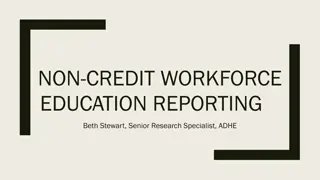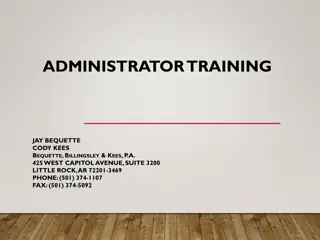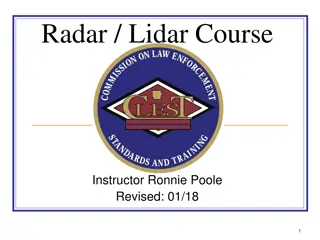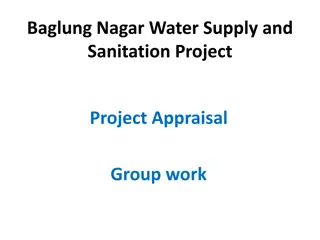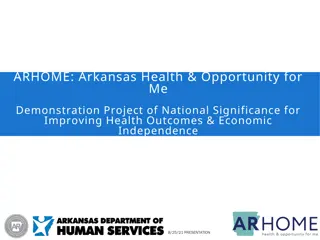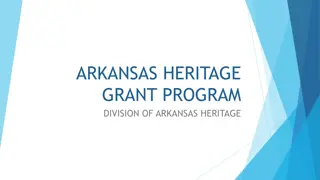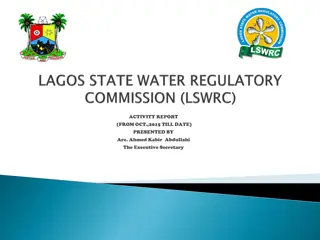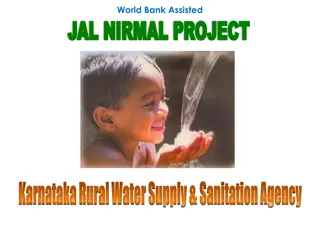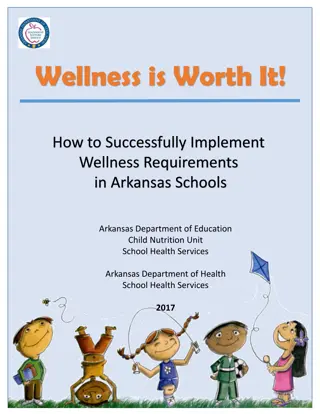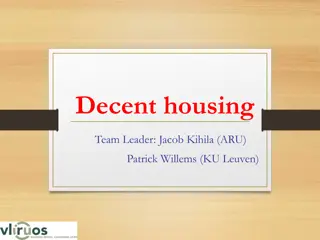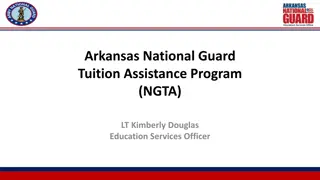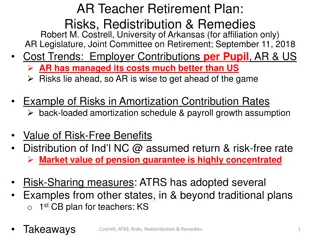Arkansas Water Laws and Regulations: Addressing Water Supply and Quality Issues for Project Development
Arkansas Water Laws and Regulations focus on the transfer and sale of water, water project development issues, and ensuring water supply and quality meet regulatory standards. The complex processes of developing new water facilities, obtaining permits, and addressing water supply challenges are discussed in depth.
Download Presentation

Please find below an Image/Link to download the presentation.
The content on the website is provided AS IS for your information and personal use only. It may not be sold, licensed, or shared on other websites without obtaining consent from the author. Download presentation by click this link. If you encounter any issues during the download, it is possible that the publisher has removed the file from their server.
E N D
Presentation Transcript
Arkansas Water Laws and Regulations Transfer/Sale of Water/ Water Project Development Issue Walter G Wright wwright@mwlaw.com
Arkansas Environmental, Energy and Water Law Blog https://www.mitchellwilliamslaw.com/blog Three posts five days a week Arkansas and surrounding states and federal legislation/regulations/judicial decisions 2
Two primary factors determine whether water is available. First is a water supply issue: Is a source of water available? Second, is a water quality issue: Assuming a source is available, is it clean enough to be treated and used? 3
Historically, water supply and water quality issues have been dealt with separately. There are vastly different regulatory schemes that provide permitting and approval oversight related to water quality and water supply projects. That availability of a safe and reliable water supply is dependent upon water that is not too impaired to efficiently treat and use. (water quality/water quantity overlap) 4
Addressing the supply issue through water development can trigger various federal statutory/regulatory programs that we will discuss The design, construction, operation, maintenance and management of facilities that provide wastewater services and water continue to generate complex issues. Alternatives to developing water supplies include purchasing and related financing issues and will discuss 5
Development of New Water Facilities/Supplies/Infrastructure The development of new facilities to extract, store, impound, and/or transport water can involve complex technical, political, legal and regulatory issues. A few strategies to consider to attempt to ease the development process might include: Start permitting early Pursue all required permits simultaneously (if possible) Example: 404 Nationwide/NPDES/ESA 6
Development of New Water Facilities/Supplies/Infrastructure (cont) Recognize Construction/Design Issues Development of water supply facilities are often complex projects Limitation of Liability Issue Waterworks and wastewater treatment plant owners that wish to retain the ability to seek compensation for the failure to meet performance standards must identify and remove these clauses in the applicable contracts and service agreement Add additional environmental benefits to project wetland mitigation, parks, conservation easements, etc. 7
Project Risk Management (Lessons Learned) Public projects requiring permits Likelihood the required permits will be appealed/challenged. Do employees/consultants recognize that most of what they write can be obtained through discovery/FOIA? Humorous comments, conservative observations, disagreements about regulatory/legal issues, etc. will be obtained by opponents if in writing. (Example NPDES appeal) All written communications should be prepared with the thought that they may appear in open court (on administrative hearing) one day. Sensitive information should be communicated orally. Critical that understanding/information/provided/etc. to government be documented. 8
Project Risk Management (Lessons Learned) (cont) Regardless of Trump Administration Environmental/Citizen Suit Activity Can Drive Compliance with Federal Statutory Standards 9
Recognize significant water source development activities could face greater challenges on certain waters Recognize creative argument/obstacles: Presence of Endangered Species Act critical habitat and/or threatened or endangered species Interstate or interbasin transfers (ANRCC Issue?) Waters whose substantial use will engender opposition by state/federal authorities, tribes or significant environmental organizations Federal reservation of rights Clean Water Act Jurisdictional Issues FERC License 10
Construction Project Risk Management The design, construction, operation, maintenance and management of facilities that provide wastewater services and water continue to generate complex issues. Recognize Risk Construction involves risk management Risk management involves identifying risk and dealing with the risk Major Causes of Disputes 1. Lack of scope definition by owner - refer to contract documents - is proposal included? - National Environmental Policy Act issue (example) 2. Improper risk allocation in contracts (stormwater examples) 11
Facility Development Performance Guarantees and Acceptance Testing Problems for water and wastewater sector: subjective standards for water quality broad range of influent parameters effluent standards that are more stringent than applicable law measuring the standards remedy if fail to meet guarantee impact of operations ability to meet guarantee 12
Facility Development (cont) The Challenges of Meeting Taste and Odor, Color and Noise Guarantees Taste, odor and color are directly related to influent what is the baseline for raw water? what happens if actual influent changes from the baseline? different ways to treat different influents Attempt to make standards of classification objective Noise what is objectionable? 13
Clear Understanding NRI Data Allentown v. O brien & Gere Engineers Problems with passive screen design which led to a problem-ridden water intake system arose directly and inevitably from engineers failure to properly analyze and draw accurate conclusions from information in its possession at all phases of the project, from evaluation through design, construction and operation. At all phases of the project engineer reported to the city only its flawed conclusions, not the data upon which its recommendations were based. Consequently, the city, which had awarded the water intake contract to engineers based upon its representations concerning the extensive background and experience of its engineers in similar projects, had no reason or basis for questioning OBG s conclusions and recommendations during the design and construction of the project. 14
The Importance of Permit and Reliance on Client Data Mobile Dredging v. Gloucester Gloucester argues that Hudson did or failed to do three things that caused it to be potentially liable to Mobile. First, the City argues that Hudson s failure to secure the DEP permit in time, attainment of which was Hudson s responsibility contributed to Mobile s damages by forcing Mobile to operate during the winter. Second, Gloucester contends that Hudson failed to verify Mobile s water pressure requirements which also delayed the start of the project and therefore also contributed to Mobile s alleged damages. Third, Gloucester maintains that if Hudson s depth calculations were wrong, as is being claimed by Mobile, Hudson would be responsible for any of the City s liability to Mobile stemming from those faulty calculations. Hudson claims that it took all necessary steps in securing the DEP permit, but that the delay can be attributed to Mobile s misrepresentation of the polymer s toxicity. 15
Environment Assessment/Services Mistake/Scope Examples: - What is the scope of work? - Do both parties have the same understanding? - Do the professionals, being utilized, have both the authority and expertise to address these issues? 16
Transactional Issues: Environmental Due Diligence Associated With A Bond Issue/Dispute Regarding Responsibility The development of infrastructure (including water related), properties, and/or districts is sometimes financed through the issuance of bonds. Like other commercial activities, the determination of whether or not past or current environmental issues might impact the operation and/or development of a bond project can be a key issue. Environmental due diligence and/or assessments may be undertaken of the project s improved or unimproved properties. The responsibility for supervising the environmental due diligence and determining the appropriate assessment activities can become a source of contention. 17
Transactional Issues: Environmental Due Diligence Associated With A Bond Issue/Dispute Regarding Responsibility (cont.) Example is found in a federal district court opinion from the Eastern District of Louisiana in Coves of the Highland Community Development District vs. McGlinchey Stafford, P.L.L.C. The opinion discusses a federal court complaint that had been filed against a law firm. The Plaintiff community development district had been established for the purpose of financing and managing a planned residential community in Louisiana. 18
Transactional Issues: Environmental Due Diligence Associated With A Bond Issue/Dispute Regarding Responsibility (cont) The opinion indicates that the law firm had been engaged to serve as counsel to the district in connection with its organization, bond issuance, and compliance activities for the real estate development. It is also states that Plaintiff alleged that Defendant verbally promised to guide and oversee the entire process and to ensure that all necessary work was performed for the project .. 19
Bond Corps of Engineers issued a public notice in which it stated that the Plaintiff s property had been used as a bombing, rocket, and gunnery range, and was the subject of an active investigation by that agency. Parish Engineer prohibited additional permits or approval until the unexploded ordinance and contamination had been fully investigated and remediated. Plaintiff alleged that it was unable to further develop the property or sell the lots, resulting in a default of the bonds. 20
Plaintiff alleged that the law firm, had a duty to conduct a reasonable investigation into the environmental issues that might delay or prevent the development. It alleged that had the law firm performed a basic environmental assessment, it would have discovered that the development project site was within the bounds of a historic bombing range. 21
Environmental Consultant Limitation of Liability Clause The CLIENT agrees to a limit Bodine s liability to the CLIENT and all parties claiming through the CLIENT or otherwise claiming reliance on Bodine s services, allegedly arising from Bodine s professional acts or errors or omissions, to a sum not to exceed Bodine s fees for the services performed on the project, provided that such claims are not attributable to Bodine s gross negligence or intentional misconduct. In this latter event, the limit of liability will be increased to $25,000 less any applicable insurance amount covering alleged damages or claims. In no event shall Bodine or any other party to this agreement, including parties which may have claimed to have paid direct or indirect reliance on Bodine s services be liable to other parties for incidental, indirect or consequential damages arising from any cause. 22
Contractual Protections to Address Environmental Issue in the Assessment/Consultant Context Scope and Limitations: - Key method for reducing the risk that work will be deemed to have breached the standard of care is often to carefully delineate the scope of work to be undertaken, including work which will not be performed wetlands/water rights?) Third Party Reliance: - The contract should explicitly limit reliance by third parties. This is accomplished by stating: That the services, data and opinions are for the sole use of the client, and are for a particular project and may be relied upon by anyone other than the client; That the data, opinions and reports are not to be distributed to the third parties without engineer s written agreement; That the services, data and options are perishable; i.e., that they should not be relied upon indefinitely; and That the agreement is not assignable. Scope of Consultant s Expertise? 23
Overview of Key Statutes Affecting Development National Environmental Policy Act (NEPA) Major federal actions such as the re-allocation or apportionment of waters between states would need to go through specific procedural requirements. While application of NEPA does not necessarily change the outcome of a federal decision on apportionment, it would require consideration of impacts from the project and alternatives to the proposed action. Major CEQ Rule Revision in 2020. 24
Non-Scope Considerations (National Environmental Policy Act) Requires the consideration of environmental impacts for any proposed construction project falling under federal jurisdiction. Projects crossing state lines (e.g., interstate pipelines), projects receiving federal funds or projects that require a federal license. Environmental issues include wetlands, wilderness areas, flood plains, threatened and endangered species, cultural resources, historical sites, noise and aesthetic issues and others. Failure to comply with procedural requirements provides opponents the opportunity to potentially enjoin activity. 25
Key NEPA Concepts NEPA Purpose? Procedural / Not Substantive Statute Jurisdictional Test Major federal action / significant impact on the environment Relevant Issues EA or EIS? Segmentation Project modifications/changes/supplement EIS? (speculative?) AWF Grand Prairie decision canal / pipeline / natural stream mix change, etc.
Key NEPA Concepts (cont) Scope of EIS Subsequent developments What range of alternatives must be considered? Cumulative impacts Example Dardanelle decision 27
2020 CEQ Revision to NEPA Rule Establishes presumptive time limits of two years for the preparation of EIS and one year for the preparation of EA Specifies presumptive page limits for EISs and EAs Requires joint schedules, a single EIS, and a single record of decision (ROD), where appropriate, for EISs involving multiple Federal agencies 28
2020 CEQ Revision to NEPA Rule (cont) Allows applicants/contractors to assume a greater role in preparing EISs with appropriate disclosure of financial or other interests and with supervision and independent evaluation by the agency Requires agencies to consider environmental effects that are reasonably foreseeable and have a reasonably close causal relationship to the proposed action Clarifies the definition of major Federal action and excludes activities with minimal Federal funding or involvement such as small business and farm loan guarantees 29
Current Arkansas NEPA Litigation I-30 Widening/Reconstruction I-630 Widening 30
Potential Role of Endangered Species In Projects/Activities (Including Water) The ESA could be a material issue or hurdle for large or small water projects if an endangered or threatened species is potentially affected. Key Sections are 7 (federal government licenses, appraisals, funding, etc.) and 9 (applies to private parties and government [take, harass, modification, etc.]) Relevant scenarios may involve development or operation of dams, reservoirs, canals, pipelines (i.e., flow, quantity issues) Dam footprint, diversion of waters, etc. can potentially trigger ESA Project might not be able to proceed, or conditions attached What is critical habitat? (Is it your water source or where you discharge?) Are species listings (and critical habitat) on the horizon that may affect your facility/activities? 31
Endangered Species Act Section 7(a)(2), 16 U.S.C. 1536(a)(2): Each Federal agency shall insure that any action authorized, funded, or carried out is not likely to jeopardize the continued existence of any endangered species or threatened species or result in the destruction or adverse modification of [critical habitat]. NO ADVERSE MODIFICATION OF CRITICAL HABITAT Section 9 Take, Harass, Modify Habitat, etc. 32
The Section 9 Take Prohibition in the Endangered Species Act Section 9 Take, Harass, Modify Habitat, etc. Applies to public and private entities Arkansas Exs. Ivory Billed Woodpecker, Burying Beetle Prohibits all kinds of taking, including direct death and injury, and harm and harassment Harass: Harass is defined as an intentional or negligent act or omission that creates the likelihood of injury to wildlife by annoying it to such an extent as to significantly disrupt normal behavior patterns . Harm: Harm is defined as any act that actually kills or injuries wildlife including significant habitat modification 33
Endangered Species Act (Continued) Overview The Endangered Species Act requires the Fish and Wildlife Service to designate critical habitat for species that are listed as endangered or threatened. Critical habitat can affect the development potential of land/waterbodies when a federal agency plays a role in the development process, for example, by contributing funding or issuing a permit for the development. Section 7 of the ESA requires federal agencies to consult with the Fish and Wildlife Service prior to taking action that could jeopardize species or modify/destroy critical habitat. Section 7 can operate to limit agency actions including issuance of permits. 34
Proposed Definition for ESA Term Habitat The U.S. Fish and Wildlife Service proposed on August 5th for the first time a regulatory definition for the term habitat as it is used in the Endangered Species Act and the various implementing regulations. (See Fed. Reg. 47333 (Aug.5, 2020) A keystone element of the Service s protection of threatened or endangered species under the ESA is the designation, conservation, and protection of critical habitat. 35
Proposed Definition for ESA Term Habitat (cont) The Service proposes to add the following definition of habitat to the definitions in the implementing regulations at 50 CFR 424.02: Habitat. The physical places that individuals of a species depend upon to carry out one or more life processes. Habitat includes areas with existing attributes that have the capacity to support individuals of the species. 36
Proposed Definition for ESA Term Habitat (cont) The Service is also soliciting comment on an alternative definition, which states: The physical places that individuals of a species use to carry out one or more life processes. Habitat includes areas where individuals of the species do not presently exist but have the capacity to support such individuals, only where the necessary attributes to support the species presently exist. 37
Endangered Species Act (Continued) Neosho Mucket/Rabbitsfoot An Arkansas Issue The United States Fish and Wildlife Service listed the Neosho mucket, a fresh water mussel, as endangered and Rabbitsfoot, a fresh water mussel, as threatened under ESA. The Service had proposed designation of critical habitat for both species. Both fresh water mussels are found in parts of Arkansas. The Service had proposed to designate a significant portion of Arkansas as critical habitat for both species. The Association of Arkansas Counties ( AAC ) and several other organizations previously submitted joint comments to the Service on the proposed designation of critical habitat for both species. 38
Endangered Species Act (Continued) Neosho Mucket/Rabbitsfoot An Arkansas Issue The AAC states in a news release: The main goal of the effort is to decrease the USFWS overly broad geographical area being proposed as critical habitat. The comments submitted by the AAC also note: The Service s proposed rule will designate a total of 769.2 river miles in Arkansas as critical habitat for Neosho muckets and Rabbitsfoot mussels. The proposed critical habitat designations will directly impact 31 Arkansas counties, and, if finalized as proposed, the targeted watershed will cover approximately 42% of the entire geographical area of Arkansas. 39
Endangered Species Act (Continued) Neosho Mucket/Rabbitsfoot An Arkansas Issue Why Important? Note: Burying Beetle Downlisting from Endangered to Threatened (and incidental take developments) 40
Endangered Species Act (Continued) Listing Activity On-Going The Center for Biological Diversity has filed an Endangered Species Act citizen suit against the United States Fish and Wildlife Service alleging a failure to protect three aquatic species The species are the trispot darter, sickle darter and yellow lance mussel. One or more of the species are found in Arkansas, Georgia, Tennessee and Virginia CBD states that the species have been adversely affected by water pollution and dams. 41
Water Flow Issues? (1) Effect on water quality Variability in surface water flow (discharge from rivers) can impact water quality Most NPDES permits are issued based on surface water flows that historically are needed to provide adequate dilution to point discharges of pollutants to the river system. For example, in the Ga., Fla. and Ala. conflict, the Apalachicola River and Bay, reduced flows increase salinity in the bay, thereby adversely impacting the bay ecosystem, including oysters and mussels, and affecting the seafood industries in Florida. 42
Water Flow Issues? (Cont) (2) Red River Compact Texas v. Oklahoma U.S. Supreme Court addressed sovereign rights of parties to the Compact. Ability of a state to resist out of state use of its water? Continuing Role of Corps of Engineers 43
Water Flow Issues? (cont) (3) The federal Water Supply Act maintains that water supply is a state and local responsibility. By authorizing COE to make the appropriate allocations or reallocation among the multiple-project purposes at each reservoir, COE arguably takes on the role of water provider. COE becomes an important source of water for municipal, industrial, and agricultural use. Important to understand role of COE in competing with other users. Recognize the COE is becoming increasingly involved in issues of water allocation. Sometime involved with a watershed management and related studies affecting a key role in water distribution and allocation. 44
Alternatives to Water Supply Development? Can water be purchased or otherwise acquired in the desired amounts in lieu of developing a new facility Contract issues are critical Certainty of supply - Physical - Legal (use ANRC rules) 45
Water Transfer/Use/Sale Issues Economic Factors Increasing demand Limited supply options Low valued uses Buyer and seller base Market data base Transaction cost consideration 46
Water Transfer/Use/Sale Issues (Cont) Technical Considerations Conveyance systems Pipelines Natural watercourses Statewide plumbing systems Urban growth PURCHASE OF REAL PROPERTY AND WATER SUPPLY IS CRITICAL: ISSUES Reservations in title? (Nilsson case water rights can be reserved) Future riparian issues? 47
Terms Point of Delivery Resale of Distribution of Water Continuity of Service Quality of Water Force Majure/ Change of Law Conservation Drought Measures Calculation of Costs Emergency Surcharge Metering Equipment Purchaser Maintenance 48
Price is Negotiable Pricing methodology dictated by lease or conveyance Pricing methodologies include: Oil & Gas pricing concepts o Guaranteed money up front oBonus oDelay Rentals oShut in payment oRoyalty payments Sold at lease Sold off lease Royalty on take or pay 49
Price is Negotiable (cont) Traditional water sales concepts Price per 1000 gallons or acre foot (lease or conveyance) Take or pay Options or reservation fees Price escalators 50






